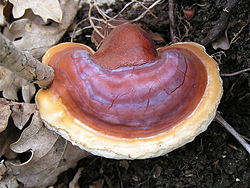Taxonomic history
The genus Ganoderma was established as a genus in 1881 by Karsten and included only one species, G. lucidum (Curtis) Karst. [1] Previously, this taxon was characterized as Boletus lucidus Curtis (1781) and then Polyporus lucidus (Curtis) Fr. (1821) (Karsten 1881). The species P. lucidus was characterized by having a laccate (shiny or polished) pileus and stipe, and this is a character that Murrill suspected was the reason for Karsten's division because only one species was included, G. lucidum . [2] Patouillard revised Karsten's genus Ganoderma to include all species with pigmented spores, adhering tubes and laccate crusted pilei, which resulted with a total of 48 species classified under the genus Ganoderma in his 1889 monograph. [3] [2] [4] Until Murrill investigated Ganoderma in North America in 1902, previous work had focused solely on European species including, for example, G. lucidum, G. resinaceum Boud. (1890) and G. valesiacum Boud. (1895). [5] [6] [2]
Phylogeny
The genus was named by Karsten in 1881. [12] Members of the family Ganodermataceae were traditionally considered difficult to classify because of the lack of reliable morphological characteristics, the overabundance of synonyms, and the widespread misuse of names. [13] [14] Until recently, the genus was divided into two sections – Ganoderma, with a shiny cap surface (like Ganoderma lucidum ), and Elfvingia, with a dull cap surface (like G. applanatum ).
Phylogenetic analysis using DNA sequence information have helped to clarify our understanding of the relationships amongst Ganoderma species. [15] [16] The genus may now be divided into six monophyletic groups: [17]
With the rise of molecular phylogenies in the late 20th century, species concept hypotheses were tested to determine the relatedness amongst the nuanced morphological variabilities of the laccate Ganoderma taxa. In 1995, Moncalvo et al constructed a phylogeny of the rDNA, which was the universally accepted locus at that time, and found five major clades of the laccate species amongst the 29 isolates tested. [18] It turned out that G. lucidum was not a monophyletic species, and further work needed to be done to clarify this taxonomic problem. They also found that G. resinaceum from Europe, and the North American 'G. lucidum', which Adaskaveg and Gilbertson found to be biologically compatible in vitro, did not cluster together. [18] [19] Moncalvo et al. reject biological species complexes as a sole tool to distinguish a taxon, and suggested using a combination between biological and phylogenetic species concepts to define unique Ganoderma taxa. [19] [18]
In 1905, American mycologist William Murrill delineated the genus Tomophagus to accommodate the single species G. colossus (then known as Polyporus colossus) which had distinctive morphological features that did not fit in with the other species. [20] Historically, however, Tomophagus has generally been regarded as a synonym for Ganoderma. [21] Nearly a century later, phylogenetic analyses vindicated Murrill's original placement, as it has shown to be a taxonomically distinct appropriate genus. [17]


